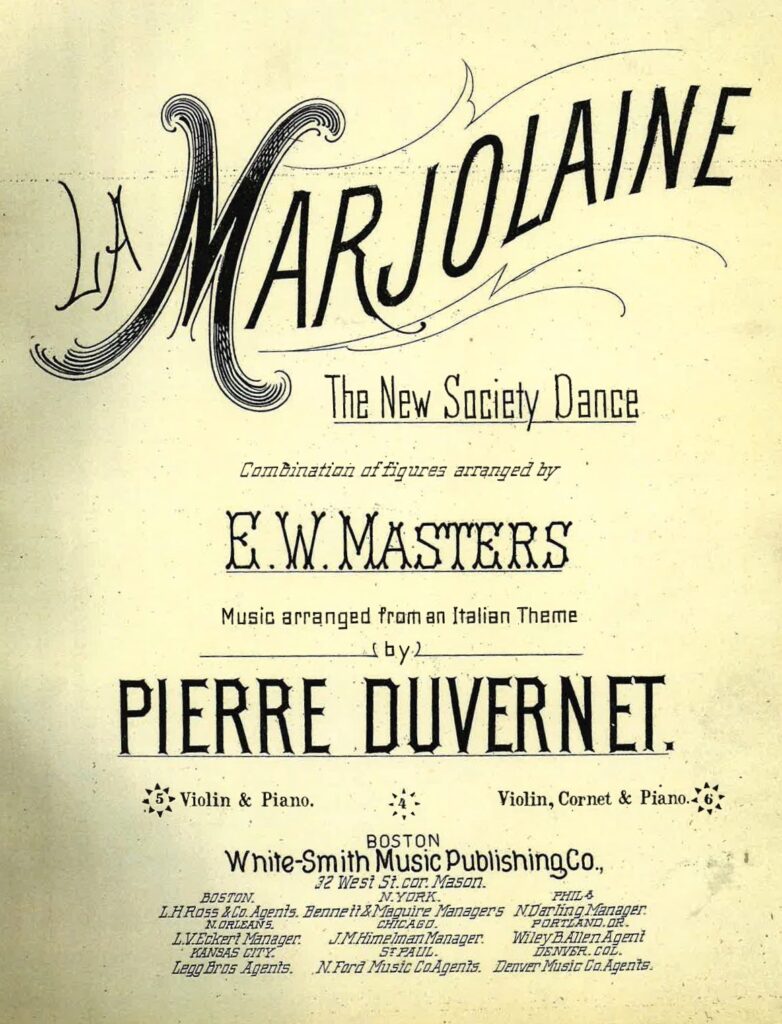La Marjolaine, The New Society Dance, was published by the White-Smith Music Publishing Co. in 1888. The music was “arranged from an Italian theme” by Pierre Duvernet with an accompanying “combination of figures” (so generic they don’t really qualify as a dance) by E. W, Masters. The title page of the sheet music may be seen below; click to enlarge.

The figures are a very simple eight-bar sequence: a typical late nineteenth century variant of the “heel and toe” polka combined with the four-slide galop. Although the dance is clearly a two-step, complete with music in 6/8, that term is never used in the instructions – an interesting hint that the two-step was not yet well-known as a term in 1888 as it would become in the 1890s.
The starting position for the dance is the “military” position (as described here), with the dancers side by side facing line of dance, the gentleman’s right arm around the lady and her left hand resting on his arm or shoulder. This is described in detail on the sheet music. The movements, per Masters, “must be made sprightly and elastic upon the toes, the heels slightly raised from the floor, toes continually kept down.”
La Marjolaine (eight bars of 6/8)
1 2 Point outside foot forward in 4th, then backward in 4th
3&4 Two-step forward leading with outside foot
1 2 Point inside foot forward in 4th, then backward in 4th
3&4 Two-step forward leading with inside foot
(take closed ballroom position)
1&2&3&4 Four-slide galop, half turn
1&2&3&4 Four-slide galop, half turn and open up to repeat from the start
These are very typical two-step figures, so short that they hardly qualify as a sequence dance. It is very similar to later sequences such as the English Très-Chic and Albert Newman’s Military Two-Step.
Reconstruction & Performance Notes
As mentioned above, the two-step is not described with that term. Instead the movements are spelled out one by one:
Advance same foot to 4th. Position, closing opposite foot to 3d. Position behind, and extend forward foot to 4th. Position, counting 1 & 2.
Detailed descriptions of the steps and timing of the two-step may be found here and here.
Similarly, the four-slide galop is not named as such, but described in more detailed terms:
glide directly to the side in line of direction En Chasse, making three slides and turning half way around on the fourth, En galopade, counting 1 & 2 & 3 & 4
The four-slide galop is described in detail in this post.
Other sources
La Marjolaine was reprinted in both M. B. Gilbert’s collection Round Dancing (Portland, Maine, 1890) and G. W. Lopp’s even larger compilation, La Danse (Paris, 1903). The instructions are all essentially the same. Gilbert shortened them by calling the starting position “the same as Military Schottische” and using “four slide galop” for the second part. He classified it under “Miscellaneous Dances” along with other dances in 6/8. Lopp, writing in French, referred to the starting position as the same as for the heel and toe polka (polka talon et pointe) and the second part as the galop glissé à quatre pas. While Lopp obviously recognized it as a two-step, since he classified it under “Les Two Step et les Three Step”, he still wrote out the first part movement by movement rather than using that term.
Music
La Marjolaine is actually a cute little tune, very sprightly and danceable. I don’t know what “Italian theme” Duvernet based it on, or even whether that was true, rather than just a promotional angle. It’s possible that it was based on a piece from Charles Lecocq’s opéra bouffe La Marjolaine (1877), though that would belie the “Italian” part.
I’m not aware of any recordings of Duvernet’s La Marjolaine, but I made a little software-generated snippet of the four-bar introduction and first thirty-two bars, enough to dance the figures through four times:
Masters gave the tempo as a dotted quarter note=120, which I followed for my snippet. Both Gilbert and Lopp managed to lose the dot in their reprints, leaving the musically peculiar (for 6/8) tempo of quarter note=120, which would be dreadfully slow and leaden for dancing.
Gilbert noted that the dance was in 6/8; since he also credited the White Smith [sic] Music Publishing Company, he presumably had access to the original sheet music. Lopp, who probably did not, offered it as for either 6/8 or 2/4 time (in which his quarter note=120 tempo would make sense). It’s interesting to watch these little errors accumulate as the dance was copied from the original to Gilbert to Lopp, whose book is in large part a translation of Gilbert, with updates and added dances.
Masters’ figures are so short and generic that they could be performed as a variation to any two-step music, as Lopp indirectly acknowledged by giving two possible time signatures. Since the first part leaves the dancers staying in place on measures one and three of each eight-bar repeat, they should be sensitive to the other couples around them and how crowded the floor is before using the figures in this way.
Many thanks to the San Francisco Public Library for providing me with a copy of the original sheet music for La Marjolaine!


Leave a Reply